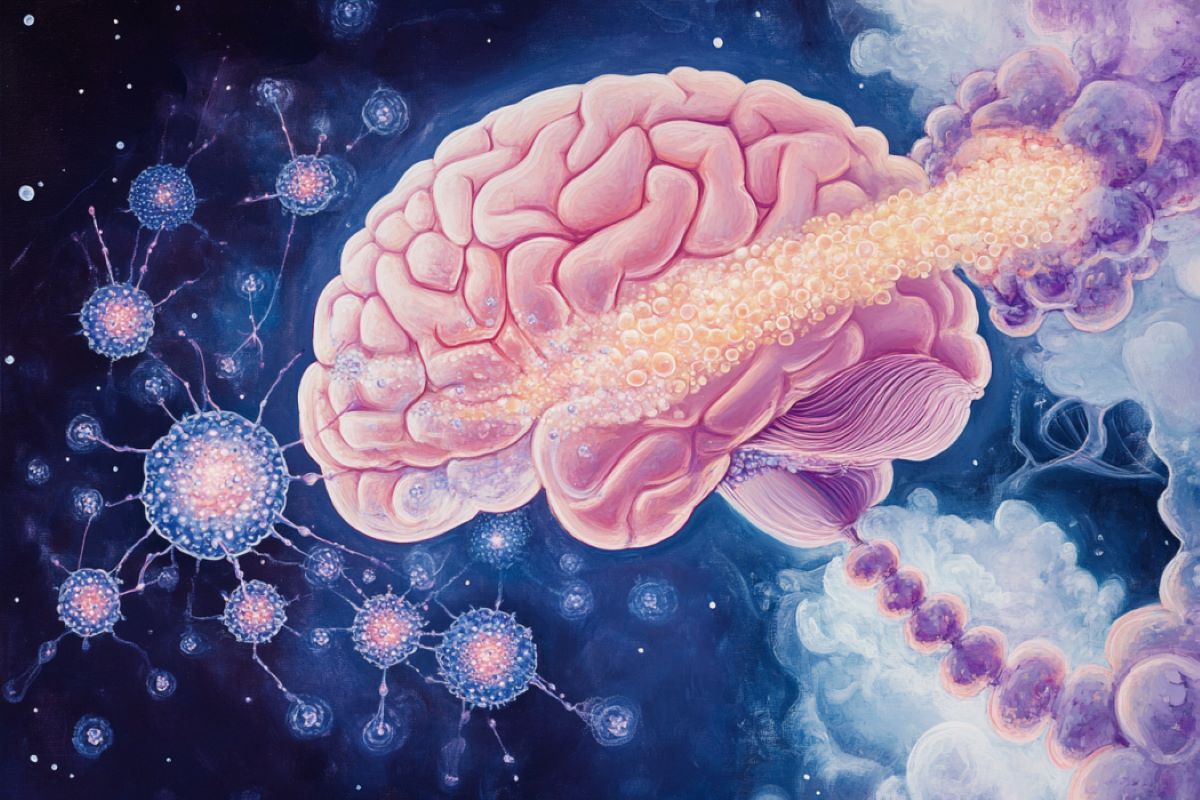Summary: A new study has developed a breakthrough biomedical tool that can deliver genetic material to edit faulty genes in fetal brain cells. Tested in mice, this technology offers the potential to stop the progression of neurodevelopmental conditions, like Angelman and Rett syndromes, before birth.
The researchers used lipid nanoparticles (LNPs) to deliver Cas9 mRNA, enabling gene editing within developing neurons. This innovative approach may one day help treat genetic disorders in-utero, preventing severe symptoms from developing after birth.
Key Facts:
- LNPs successfully deliver Cas9 mRNA to fetal brain cells, enabling gene edits.
- The tool was able to transfect 30% of brain stem cells, allowing wide impact.
- Early intervention could prevent neurodevelopmental disorders like Angelman syndrome.
Source: UC Davis
A new study shows that a biomedical tool can successfully deliver genetic material to edit faulty genes in developing fetal brain cells.
The technology, tested in mice, might have the potential to stop the progression of genetic-based neurodevelopmental conditions, such as Angelman syndrome and Rett syndrome before birth.
“The implications of this tool for treating neurodevelopmental conditions are profound. We can potentially correct genetic anomalies at a foundational level during critical periods of brain development,” said the study’s senior author Aijun Wang, a UC Davis professor of surgery and biomedical engineering.

The study, a collaboration between the Wang Lab and the Murthy Lab at UC Berkeley, was published today in ACS Nano.
The team hopes to develop this technology into treatments for genetic conditions that can be diagnosed during prenatal testing. The treatments can be given in the womb to avoid more damage as cells develop and mature.
A complex transportation system with a revolutionary delivery method
Proteins have a crucial role in the way our bodies function. In certain genetic conditions, the genes express (produce) more or fewer protein than the body needs. In such cases, the body might get dysregulated.
The scientists found a way to deliver messenger RNA (mRNA) to cells that will be translated to functional proteins. This delivery method uses a unique lipid nanoparticle (LNP) formulation to carry mRNA. The objective is to introduce (transfect) mRNA genetic material into the cells. The mRNA then would translate instructions to build proteins.
In a recent Nature Nanotechnology paper, Wang, Murthy and their team described a new LNP formulation to safely and efficiently deliver mRNA. LNPs carrying mRNA need to arrive at the cells, where they will be taken in through a process known as endocytosis. There, the cell breaks the LNP carrier, which allows the mRNA cargo to be released.
“The LNPs developed in this study use a new acid degradable linker that enables the LNPs to rapidly degrade inside of cells. The new linker also enables LNPs to be engineered to have lower toxicity,” said Niren Murthy, professor of bioengineering at the University of California at Berkeley and co-investigator on this project.
Efficiency is closely linked to toxicity. If the uptake efficiency is low, scientists will need to use a lot of nanoparticles. This means multiple doses or high doses that can cause a toxic immune response.
“The biggest hurdle to deliver mRNA to the central nervous system so far has been toxicity that leads to inflammation,” Wang said.
The study showed that the LNP method is more efficient at mRNA translation, reducing the need for potentially toxic doses.
Sending the manual to build the CAS9 enzyme for gene editing
The new study describes the use of the LNP technology for Cas9 mRNA delivery to treat central nervous system genetic diseases in utero. The researchers tested their tool on the gene responsible for Angelman syndrome, a rare neurodevelopmental condition.
In a genetic condition, damage accumulates during gestation and soon after birth. Research shows that it is more efficient to deliver therapies to the brain cells before the blood-brain barrier in babies is fully formed. So, the earlier the correction happens, the better. The idea was to stop the disease progression in-utero.
The researchers injected the LNP with the mRNA into the fetal brain’s ventricles in a mouse model. The mRNA translates into CAS9, a protein that works like scissors for gene editing. The produced CAS9 will edit the gene responsible for Angelman syndrome.
“The mRNA is like the Lego manual that has instructions to put the pieces together to form functional proteins. The cell itself has all the pieces to build CAS9. We just have to supply the mRNA sequence, and the cell will take and translate it into proteins,” Wang explained.
Findings
The study showed that the LNP tool was very efficient in delivering the mRNA that translated into CAS 9.
Using tracers, the researchers could see all the neurons that were edited inside the brain. Their study showed that the nanoparticles were taken up by the brain’s developing neural stem and progenitor cells. The nanoparticles led to gene edits in 30% of the brain stem cells in the mouse model.
“Transfecting 30% of the whole brain, especially the stem cells, is a big deal. These cells migrate and spread to many places across the brain as the fetus further develops,” Wang said.
In the study, as the fetal development continued, the stem cells proliferated and migrated to form the central nervous system. The study revealed that more than 60% of the neurons in the hippocampus and 40% of neurons in the cortex were transfected.
“This is a very promising method for genetic conditions affecting the central nervous system. When the babies are born, many of the neurons could have been corrected. This means the baby could be born with no symptoms,” Wang explained.
Wang expects to see an even higher percentage of transfected cells in a diseased mouse model.
“Bad neurons with mutation may be killed by the accumulation of disease symptoms and good neurons may stay and proliferate. This could lead to amplified therapeutic efficiency. If we know well enough how cells work, we can leverage this knowledge to cooperate with the naturally occurring pathways in the cell,” he said.
About this gene editing and neurodevelopment research news
Author: Nadine Yehya
Source: UC Davis
Contact: Nadine Yehya – UC Davis
Image: The image is credited to Neuroscience News
Original Research: Open access.
“Widespread Gene Editing in the Brain via In Utero Delivery of mRNA Using Acid-Degradable Lipid Nanoparticles” by Aijun Wang et al. ACS Nano
Abstract
Widespread Gene Editing in the Brain via In Utero Delivery of mRNA Using Acid-Degradable Lipid Nanoparticles
In utero gene editing with mRNA-based therapeutics has the potential to revolutionize the treatment of neurodevelopmental disorders. However, a critical bottleneck in clinical application has been the lack of mRNA delivery vehicles that can efficiently transfect cells in the brain.
In this report, we demonstrate that in utero intracerebroventricular (ICV) injection of densely PEGylated lipid nanoparticles (ADP-LNPs) containing an acid-degradable PEG–lipid can safely and effectively deliver mRNA for gene editing enzymes to the fetal mouse brain, resulting in successful transfection and editing of brain cells.
ADP-LNPs containing Cre mRNA transfected 30% of the fetal brain cells in Ai9 mice and had no detectable adverse effects on fetal development and postnatal growth. In addition, ADP-LNPs efficiently transfected neural stem and progenitor cells in Ai9 mice with Cre mRNA, which subsequently proliferated and caused over 40% of the cortical neurons and 60% of the hippocampal neurons to be edited in treated mice 10 weeks after birth.
Furthermore, using Angelman syndrome, a paradigmatic neurodevelopmental disorder, as a disease model, we demonstrate that ADP-LNPs carrying Cas9 mRNA and gRNA induced indels in 21% of brain cells within 7 days postpartum, underscoring the precision and potential of this approach.
These findings demonstrate that LNP/mRNA complexes have the potential to be a transformative tool for in utero treatment of neurodevelopmental disorders and set the stage for a frontier in treating neurodevelopmental disorders that focuses on curing genetic diseases before birth.






